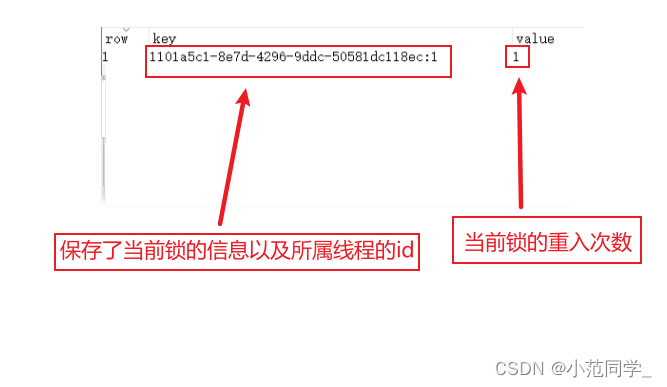异常信息
org.redisson.client.RedisException: WRONGTYPE Operation against a key holding the wrong kind of value.
结论
- 分布式锁使用的key和别的键值对共用了同一个键
为什么这么说呢,写一段junit测试代码,这里RedissonClient配置就不展示了,有兴趣可以自行去了解一下
@RunWith(SpringRunner.class)
@SpringBootTest(classes = AccountServiceApplication.class)
class IScMemberProfitImplServiceTest {
@Autowired
private RedissonClient redissonClient;
@Test
void testRedisson() {
//获取12345678对应的键
RBucket<Object> bucket = redissonClient.getBucket("12345678");
//获取键对应的值(此时为null)
String o1 = (String)bucket.get();
//设置同样的key
RLock lock = redissonClient.getLock("12345678");
//获取分布式锁,有效期2分钟
lock.lock(2, TimeUnit.MINUTES);
//测试重入锁
//lock.lock(2, TimeUnit.MINUTES);
//lock.lock(2, TimeUnit.MINUTES);
//设置这个键对应的值为999,有效期为两分钟
bucket.set("999",2, TimeUnit.MINUTES);
//释放分布式锁
if(lock.isLocked()){
if(lock.isHeldByCurrentThread()){
lock.unlock();
}
}
}
运行完以上代码,线程在 if(lock.isHeldByCurrentThread()){ 处抛出如题异常,
回看以上代码,在分布式锁获取后,查看redis看到,redis中‘12345678’对应存的hash类型,内容如下

那运行到bucket.set("999",2, TimeUnit.MINUTES); 为什么不会报错呢? 分布式锁存储了hash类型,这不跟String类型冲突了吗
emmm,这要是在mysql确实执行不过去,但对于redis来说,set就意味着直接覆盖,因此,原来存储的不管是什么类型,都会直接覆盖
那为什么执行到if(lock.isHeldByCurrentThread()){ 这里又会报错呢?
额,接着上面所说,由于键 “12345678” 对应的值呗覆盖成了 “999” 字符串,线程执行到此行代码是,判断当前执行的线程是否与redis中存储的线程信息一致,但redis中的值结构已经不再是hash类型,因此会抛出异常






















 2013
2013











 被折叠的 条评论
为什么被折叠?
被折叠的 条评论
为什么被折叠?








